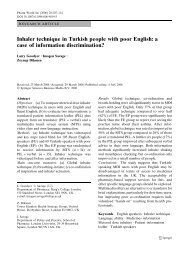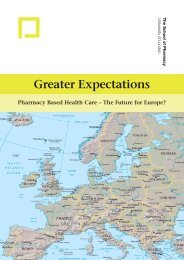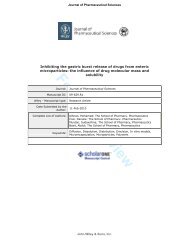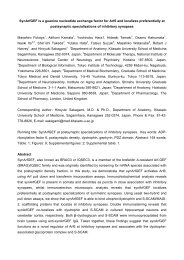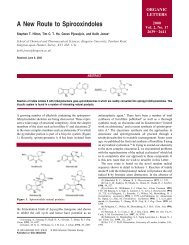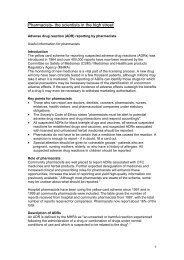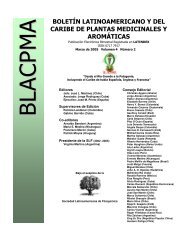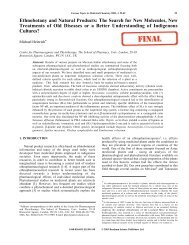Measurement of the percentage volume particle ... - Pharmacy Eprints
Measurement of the percentage volume particle ... - Pharmacy Eprints
Measurement of the percentage volume particle ... - Pharmacy Eprints
Create successful ePaper yourself
Turn your PDF publications into a flip-book with our unique Google optimized e-Paper software.
<strong>Measurement</strong> <strong>of</strong> <strong>the</strong> <strong>percentage</strong> <strong>volume</strong> <strong>particle</strong> size<br />
distribution <strong>of</strong> powdered microcrystalline cellulose using<br />
reflectance near-infrared spectroscopy†<br />
Andrew J. O’Neil, Roger D. Jee and Anthony C. M<strong>of</strong>fat*<br />
Centre for Pharmaceutical Analysis, The School <strong>of</strong> <strong>Pharmacy</strong>, University <strong>of</strong> London, 29/39<br />
Brunswick Square, London, UK WC1N 1AX<br />
Received 25th June 2003, Accepted 29th September 2003<br />
First published as an Advance Article on <strong>the</strong> web 13th October 2003<br />
This is <strong>the</strong> first reported method for determining <strong>the</strong> <strong>percentage</strong> <strong>volume</strong> <strong>particle</strong> size distribution <strong>of</strong> a powder<br />
(microcrystalline cellulose) by near-infrared (NIR) reflectance spectroscopy. A total <strong>of</strong> 113 samples <strong>of</strong> powdered<br />
microcrystalline cellulose were used from six different commercially available grades, with different moisture<br />
contents (range: 0.9–4.8% m/m). NIR reflectance measurements <strong>of</strong> <strong>the</strong>se samples were made in narrow soda glass<br />
vials. Reference <strong>particle</strong> size data for <strong>the</strong> samples were acquired by laser diffraction. The NIR data were <strong>the</strong>n<br />
calibrated to measure <strong>particle</strong> size by partial least squares regression. The effects <strong>of</strong> a range <strong>of</strong> different NIR data<br />
pre-treatments on calibration and prediction precision were investigated. Overall, simple absorbance data were<br />
found to produce regression models with <strong>the</strong> best predictive ability (root mean square error <strong>of</strong> prediction =<br />
0.90%). The method was also found to be insensitive to moisture content.<br />
Introduction<br />
Determination <strong>of</strong> powdered pharmaceutical material <strong>particle</strong><br />
size is important 1,2 since a material’s <strong>particle</strong> size distribution<br />
exerts a significant effect on <strong>the</strong> physical properties <strong>of</strong> <strong>the</strong> bulk<br />
material. 3 As a consequence <strong>of</strong> this, <strong>particle</strong> size measurements<br />
are routinely performed on raw materials prior to commencement<br />
<strong>of</strong> pharmaceutical manufacture. 4 The techniques typically<br />
used for measurement include forward angle laser light<br />
scattering (FALLS) and electrical zone sensing. 5 Though<br />
accurate, <strong>the</strong>se methods suffer from <strong>the</strong> disadvantage <strong>of</strong> being<br />
time consuming and may <strong>the</strong>refore delay manufacture. 6<br />
The potential application <strong>of</strong> near-infrared (NIR) spectroscopy<br />
with its ability to analyse rapidly powdered materials and<br />
with minimal sample preparation, has long been suggested for<br />
<strong>particle</strong> size determination <strong>of</strong> powdered pharmaceuticals. 7–9<br />
Pasikatan et al. 10 has reviewed <strong>the</strong> near-infrared literature on<br />
<strong>particle</strong> size measurements. Despite <strong>the</strong>se suggestions, NIR has<br />
remained largely a technique used for chemical analysis. 11<br />
Powdered pharmaceutical materials may be suited for NIR<br />
<strong>particle</strong> size determinations since <strong>the</strong>y are diffusely reflecting<br />
materials. 7 In <strong>the</strong> NIR region (1000 nm to 2500 nm) <strong>the</strong>se<br />
materials both absorb and scatter light, 7 resulting in spectra with<br />
overlapping absorption bands, non-uniform baselines and<br />
varying <strong>of</strong>fsets. The effects <strong>of</strong> scatter have been shown to vary<br />
with <strong>the</strong> <strong>particle</strong> size, 9 sample porosity 6 (and hence compaction<br />
pressure) and with <strong>the</strong> wavelength 12 and can be described using<br />
Rayleigh and Mie <strong>the</strong>ory, 13 or alternatively using <strong>the</strong> Kubelka–<br />
Munk <strong>the</strong>ory <strong>of</strong> diffuse reflectance. 13<br />
Previous studies that have examined <strong>the</strong> effects <strong>of</strong> <strong>particle</strong><br />
size on NIR spectra have demonstrated that reflectance varies<br />
non-linearly with <strong>particle</strong> size. 7,13–15 Ciurczak et al. 7 found that<br />
reflectance exhibited an inverse relationship with mean <strong>particle</strong><br />
size in agreement with Mie <strong>the</strong>ory. 13 However, this relationship<br />
does not necessarily apply in all cases and is dependent on <strong>the</strong><br />
shape <strong>of</strong> <strong>the</strong> <strong>particle</strong> size distribution <strong>of</strong> <strong>the</strong> sample, <strong>the</strong> <strong>particle</strong><br />
shape and <strong>the</strong> material’s refractive index. 13 The presence <strong>of</strong><br />
very small <strong>particle</strong>s will fur<strong>the</strong>r complicate <strong>the</strong> relationship as<br />
† Electronic supplementary information (ESI) available: Particle size and<br />
spectral data. See http://www.rsc.org/suppdata/an/b3/b307263k/<br />
THE<br />
ANALYST<br />
FULL PAPER<br />
www.rsc.org/analyst<br />
<strong>the</strong>se may exhibit Rayleigh scatter, which is proportional to <strong>the</strong><br />
third power <strong>of</strong> <strong>the</strong> <strong>particle</strong> size. 13 Although NIR spectroscopy<br />
has been used for <strong>the</strong> measurement <strong>of</strong> nano<strong>particle</strong>s. 16<br />
The complicated relationship between reflectance at a<br />
spectral wavelength and <strong>particle</strong> size has resulted in most work<br />
in this area focusing on chemometric calibration methods,<br />
ra<strong>the</strong>r than <strong>the</strong>oretical models. 9,15,17 A novel method for<br />
classifying pharmaceutical powders involved transforming<br />
second derivative NIR spectra to polar co-ordinates. 9 Each NIR<br />
spectrum was reduced to a single quality point in a plane, that<br />
could be plotted in Cartesian co-ordinates. Linear plots <strong>of</strong> <strong>the</strong><br />
logarithm <strong>of</strong> <strong>the</strong> <strong>particle</strong> size versus <strong>the</strong> x or y co-ordinate were<br />
found to show significant correlation.<br />
Multivariate calibration methods have proven most successful<br />
in calibrating NIR data to measure <strong>particle</strong> size. One recent<br />
application 18 determined <strong>the</strong> median <strong>particle</strong> size <strong>of</strong> drugs by<br />
multiple linear regression whilst Frake et al. 19,20 used neural<br />
networks.<br />
A significant advance was <strong>the</strong> production <strong>of</strong> calibrations to<br />
measure <strong>the</strong> cumulative <strong>particle</strong> size distribution, at interpolated<br />
cumulative <strong>percentage</strong> intervals (range: 5% to 95%, in 11<br />
discrete steps) using multiple linear least squares regression<br />
(MLR) and principal components regression. 21 However,<br />
because <strong>the</strong> method involved modelling each discrete interval,<br />
and <strong>the</strong> method used fewer <strong>particle</strong> size intervals than <strong>the</strong><br />
original laser diffraction data for modelling, it consequently<br />
produced predicted distributions with less detail than in <strong>the</strong><br />
original reference method’s distributions.<br />
The aim <strong>of</strong> this work was to produce a procedure for NIR<br />
calibrations to measure <strong>the</strong> <strong>percentage</strong> <strong>volume</strong> <strong>particle</strong> size<br />
distributions <strong>of</strong> powdered microcrystalline cellulose using all<br />
<strong>the</strong> data from <strong>the</strong> reference (laser diffraction) method in one<br />
ma<strong>the</strong>matical step using partial least squares regression.<br />
Experimental<br />
Instrumentation<br />
NIR reflectance measurements <strong>of</strong> <strong>the</strong> powdered samples were<br />
made using a FOSS instruments grating spectrometer (Model<br />
1326 Analyst, 2003, 128, 1326–1330<br />
This journal is © The Royal Society <strong>of</strong> Chemistry 2003<br />
DOI: 10.1039/b307263k
6500, FOSS NIRSystems, Silver Springs, MD, USA) equipped<br />
with a rapid content analyser module. Particle size distribution<br />
data for <strong>the</strong> microcrystalline cellulose samples were acquired by<br />
laser diffraction using a Malvern Mastersizer X Laser Diffraction<br />
instrument (Malvern Instruments, Malvern, UK) equipped<br />
with a dry powder feeder.<br />
Materials<br />
The microcrystalline cellulose samples used were obtained<br />
from one supplier (FMC International, Wallingstown, Little<br />
Island, Co Cork, Ireland). These samples (n = 113 from 109<br />
different batches with 2 samples from each <strong>of</strong> 4 <strong>of</strong> <strong>the</strong> batches)<br />
were from six different grades with different median <strong>particle</strong><br />
sizes (range <strong>of</strong> <strong>percentage</strong> <strong>volume</strong> median <strong>particle</strong> sizes:<br />
14.96–198.6 mm; mean <strong>of</strong> <strong>percentage</strong> <strong>volume</strong> median <strong>particle</strong><br />
sizes = 95.47 mm) and moisture contents which ranged from<br />
0.9 to 4.8% m/m.<br />
Sample preparation and presentation<br />
A single narrow soda glass vial was filled with material for each<br />
powdered sample. A NIR diffuse reflectance spectrum was <strong>the</strong>n<br />
recorded as Log10(1/R), where R is <strong>the</strong> reflectance, for each<br />
sample as <strong>the</strong> average <strong>of</strong> 32 scans, over <strong>the</strong> wavelength range<br />
1100 to 2498 nm, at 2 nm increments (700 data points).<br />
Reference <strong>particle</strong> size data for each sample were acquired by<br />
laser diffraction with a dry powder feeder.<br />
Data analysis<br />
Data were processed using programmes written in Matlab 5<br />
Scientific and Technical Programming language (The Mathworks<br />
Inc., Natick, MA, USA). The near-infrared spectra and<br />
<strong>particle</strong> size data are available as Electronic Supplementary<br />
Information (ESI)†.<br />
Results and discussion<br />
Particle size and spectral characteristics<br />
The six different grades <strong>of</strong> microcrystalline cellulose were<br />
found to broadly fit into seven distinct <strong>particle</strong> size distributions<br />
(Fig. 1). These distributions varied from narrow and very<br />
positively skewed to broad slightly negative skewed distributions<br />
(d90–d10 ranged from 34.4 to 266.2 mm). While a more<br />
evenly distributed set <strong>of</strong> values in each <strong>particle</strong> size channel<br />
would have been desirable, <strong>the</strong> data was adequate for demonstrating<br />
<strong>the</strong> feasability <strong>of</strong> measuring <strong>particle</strong> size distributions<br />
by NIR spectroscopy.<br />
All absorbance spectra exhibited non-uniform baselines and<br />
overlapped combinations and overtones from <strong>the</strong> mid-infrared<br />
region. The non-uniform baselines observed were <strong>the</strong> result <strong>of</strong><br />
multiple scatter which has been shown to be due to both <strong>particle</strong><br />
size and surface moisture content (Fig. 2a).<br />
Spectral data pre-treatments<br />
A range <strong>of</strong> data pre-treatments commonly employed in NIR<br />
spectrometry were applied to <strong>the</strong> spectral data and <strong>the</strong>ir effects<br />
on calibration and prediction precision were compared against<br />
results for absorbance (Log10(1/R)) data. The data pretreatments<br />
tested were: standard normal variate (SNV), 22<br />
quadratic baseline correction (‘detrend’), 22 SNV coupled with<br />
detrend 22 and Savitzky-Golay 11 point quadratic second<br />
derivative 23 (Fig. 2).<br />
Owing to <strong>the</strong> increase in noise in <strong>the</strong> Savitzky-Golay<br />
smoo<strong>the</strong>d second derivative spectra beyond 2200 nm, <strong>the</strong><br />
wavelength range used with this pre-treated data was truncated<br />
to 1110 to 2200 nm (546 data points).<br />
Preliminary data analysis<br />
The Malvern Mastersizer measured both <strong>the</strong> <strong>percentage</strong> <strong>volume</strong><br />
and <strong>the</strong> <strong>percentage</strong> cumulative <strong>volume</strong> <strong>particle</strong> size distributions<br />
in 32 different channels. The channels’ width followed a<br />
geometric progression so that <strong>the</strong>y had <strong>the</strong> same resolution<br />
(channel width divided by <strong>the</strong> diameter in <strong>the</strong> centre <strong>of</strong> <strong>the</strong><br />
channel). For calibration purposes, <strong>the</strong> mean value between <strong>the</strong><br />
low and high <strong>particle</strong> sizes for a given channel were used (range:<br />
0.9–448.3 mm). Preliminary investigation <strong>of</strong> <strong>the</strong> total <strong>particle</strong><br />
size data set revealed that <strong>the</strong> largest <strong>particle</strong> size channel did<br />
not contain any useful information, hence this channel was<br />
removed from <strong>the</strong> data set giving 31 channels for calibration.<br />
With <strong>the</strong> data sets and chemometric techniques used previously,<br />
18,21 it was not found possible to produce accurate<br />
calibrations for <strong>the</strong> <strong>percentage</strong> <strong>volume</strong> <strong>particle</strong> size distribution.<br />
The requirement was to model all 31 channels from <strong>the</strong> laser<br />
diffraction instrument (sets <strong>of</strong> <strong>particle</strong> sizes) and preliminary<br />
investigation showed that this could be calibrated by a PLS2<br />
model. The PLS2 model allowed all <strong>the</strong> <strong>particle</strong> size channels to<br />
Fig. 1 Percentage (a) <strong>volume</strong> and (b) cumulative <strong>volume</strong> <strong>particle</strong> size<br />
distributions for <strong>the</strong> microcrystalline cellulose samples (n = 113). Note,<br />
lines drawn between <strong>the</strong> mid points <strong>of</strong> each channel in (a). Channel widths<br />
follow a geometric progression.<br />
Analyst, 2003, 128, 1326–1330 1327
e modelled at <strong>the</strong> same time, ra<strong>the</strong>r than one at a time as with<br />
conventional PLS1 models. 24<br />
Model generation<br />
Regression models for <strong>particle</strong> size distribution data were<br />
produced with original and pre-treated NIR spectral data by<br />
PLS2. 24 This summarises <strong>the</strong> important variability in both <strong>the</strong><br />
NIR spectral data (X) and <strong>the</strong> <strong>particle</strong> size data (Y). This<br />
procedure projected <strong>the</strong> information in <strong>the</strong> high-dimensional<br />
data spaces (X, Y) down onto low-dimensional spaces defined<br />
by a small number <strong>of</strong> latent variables. The X and Y data sets<br />
were first mean-centred and scaled to unit variance.<br />
The number <strong>of</strong> PLS2 dimensions, a, for each <strong>of</strong> <strong>the</strong> pretreated<br />
data sets (X, Y) were estimated by cross-validation. For<br />
this, <strong>the</strong> first 110 <strong>of</strong> 113 observations (X, Y) were divided into<br />
11 subsets <strong>of</strong> 10 observations. Next, calculation <strong>of</strong> PLS2 models<br />
<strong>of</strong> rank a (where a = 1, 2, 3, …) was performed for all<br />
combinations <strong>of</strong> 10 <strong>of</strong> <strong>the</strong> 11 subsets <strong>of</strong> data. With each PLS2<br />
model, <strong>the</strong> remaining subset <strong>of</strong> NIR spectral and <strong>particle</strong> size<br />
data was used to test <strong>the</strong> goodness <strong>of</strong> fit <strong>of</strong> <strong>the</strong> model (a PLS2<br />
dimensions) by measuring <strong>the</strong> predicted residual error sum <strong>of</strong><br />
squares (PRESS) between model predicted and reference<br />
<strong>particle</strong> size data. This approach <strong>of</strong> dividing <strong>the</strong> data into subsets<br />
was preferable to ‘leave-one-out-cross-validation’, requiring<br />
considerably less computation time. The number <strong>of</strong> PLS2<br />
components required to extract <strong>the</strong> information from X and Y<br />
was that number a with <strong>the</strong> lowest PRESS value.<br />
Rank <strong>of</strong> PLS2 models<br />
With <strong>the</strong> exception <strong>of</strong> <strong>the</strong> model produced with Savitzky–Golay<br />
second derivative data, 6 PLS2 components were required to fit<br />
<strong>the</strong> data and give <strong>the</strong> lowest PRESS value (Table 1). Clearly, <strong>the</strong><br />
Savitzky–Golay smoo<strong>the</strong>d second derivative did remove more<br />
scatter and baseline drift information from <strong>the</strong> NIR data than <strong>the</strong><br />
o<strong>the</strong>r pre-treatments, requiring only 4 components to model <strong>the</strong><br />
Table 1 PLS2 results <strong>of</strong> cross validation, calibration and prediction for <strong>the</strong><br />
NIR data sets tested<br />
Fig. 2 NIR spectra <strong>of</strong> microcrystalline cellulose <strong>of</strong> different <strong>volume</strong> median sizes (from bottom to top) 14.96, 53.34, 86.67, 99.03, 119.91 and 171.96 mm<br />
and spectral pre-treatments: (a) absorbance, (b) SNV <strong>of</strong> absorbance, (c) detrend <strong>of</strong> absorbance, (d) SNV <strong>of</strong> absorbance and (e) Savitzky-Golay 11 point<br />
quadratic second derivative <strong>of</strong> absorbance.<br />
1328 Analyst, 2003, 128, 1326–1330<br />
Data<br />
PLS<br />
components PRESS a<br />
RMSEP<br />
(%) b<br />
Absorbance 6 0.220 0.90<br />
SNV 6 0.165 1.03<br />
SNV detrend 6 0.167 1.08<br />
Detrend 6 0.193 1.07<br />
Savitzky–Golay 2nd derivative 4 0.201 1.69<br />
a Predicted residual error sum <strong>of</strong> squares using mean centred and<br />
standardised <strong>particle</strong> size data. b Root mean square error <strong>of</strong> prediction for<br />
predicted <strong>particle</strong> size data.<br />
Fig. 3 Predicted residual error sum <strong>of</strong> squares (PRESS) for successive<br />
PLS2 components extracted using NIR absorbance and laser diffraction<br />
data.
data. With all data pre-treatments tested, typical idealised plots<br />
<strong>of</strong> PRESS versus number <strong>of</strong> PLS components were obtained,<br />
with clear minima. This is shown for <strong>the</strong> absorbance data set in<br />
Fig. 3. The SNV transformation provided a model with <strong>the</strong><br />
lowest PRESS value. All o<strong>the</strong>r pre-treated NIR data sets<br />
produced models with low PRESS values except for absorbance<br />
data which had <strong>the</strong> highest PRESS value—a third greater than<br />
for <strong>the</strong> model derived from SNV data (Table 1).<br />
Calibration and validation precision<br />
In order to test <strong>the</strong> predictive capacity <strong>of</strong> <strong>the</strong> method, <strong>the</strong> NIR<br />
<strong>particle</strong> size data set was split into a calibration and a validation<br />
set. For PLS2 modelling, 90 spectra and <strong>particle</strong> size results<br />
were randomly selected for calibration (range <strong>of</strong> <strong>percentage</strong><br />
<strong>volume</strong> median <strong>particle</strong> sizes: 14.96–198.6 mm; mean <strong>of</strong><br />
<strong>percentage</strong> <strong>volume</strong> median <strong>particle</strong> sizes = 102.3 mm). The<br />
Fig. 4 Plots <strong>of</strong> laser diffraction measured <strong>percentage</strong> <strong>volume</strong> distributions for <strong>the</strong> validation samples (n = 23) with NIR predicted values (+) overlaid.<br />
Analyst, 2003, 128, 1326–1330 1329
emaining 23 samples were used to test <strong>the</strong> predictive abilities<br />
<strong>of</strong> <strong>the</strong> models (range <strong>of</strong> <strong>percentage</strong> <strong>volume</strong> median <strong>particle</strong><br />
sizes: 15.15–126.3 mm; mean <strong>of</strong> <strong>percentage</strong> <strong>volume</strong> median<br />
<strong>particle</strong> sizes: 68.74 mm). PLS2 models for original and pretreated<br />
NIR-<strong>particle</strong> size data were created from <strong>the</strong> calibration<br />
data sets, each having <strong>the</strong> number <strong>of</strong> components determined by<br />
cross-validation. The predictive ability <strong>of</strong> <strong>the</strong> models were<br />
determined using <strong>the</strong> validation data sets by calculation <strong>of</strong> <strong>the</strong><br />
root mean square error <strong>of</strong> prediction (RMSEP, eqn. 1) between<br />
PLS2 model predicted and reference <strong>percentage</strong> frequency, y,<br />
over all channels, m, and samples, n:<br />
The best predictive model was obtained using absorbance<br />
data which produced <strong>the</strong> lowest prediction errors: RMSEP =<br />
0.90% (Table 1). The SNV, detrend and SNV-detrend pretreatments<br />
also produced models which showed low prediction<br />
errors (range: 1.03 to 1.08%), however <strong>the</strong>se were higher than<br />
those obtained with absorbance data (Table 1). The Savitzky–<br />
Golay smoo<strong>the</strong>d second derivative transformation produced a<br />
model with far higher prediction errors, with an RMSEP nearly<br />
double than that obtained with absorbance data (Table 1). Plots<br />
<strong>of</strong> <strong>percentage</strong> <strong>volume</strong> <strong>particle</strong> size distributions for <strong>the</strong> 23<br />
validation samples are shown in Fig. 4 and show <strong>the</strong> very good<br />
agreement <strong>of</strong> <strong>the</strong> NIR predicted results with those obtained by<br />
laser diffraction. For example, Fig. 3a shows excellent agreement<br />
over <strong>the</strong> whole range <strong>of</strong> <strong>particle</strong> sizes studied (0.9–448.3<br />
mm). Bimodal distributions were also reasonable well modelled<br />
(Fig. 4f and m) and even skewed distributions were modelled<br />
well (Fig. 4d and t).<br />
The linear association between NIR predicted and laser<br />
diffraction analysis measured <strong>percentage</strong> <strong>volume</strong> for <strong>the</strong><br />
validation set (all 23 samples and 31 channels) was found to<br />
have a highly significant correlation, r, <strong>of</strong> 0.97 (n = 713, p =<br />
0.005), with a slope <strong>of</strong> 1.008 and intercept <strong>of</strong> 20.024%.<br />
The method was also insensitive to <strong>the</strong> moisture content <strong>of</strong><br />
<strong>the</strong> samples. No significant correlation between <strong>the</strong> d10, d50 and<br />
d90 reference <strong>particle</strong> size values and moisture content <strong>of</strong> <strong>the</strong><br />
samples was found (probability for no correlation: 0.115, 0.212<br />
and 0.274 respectively).<br />
Conclusion<br />
The measurement <strong>of</strong> <strong>the</strong> <strong>percentage</strong> <strong>volume</strong> <strong>particle</strong> size<br />
distribution <strong>of</strong> powdered microcrystalline cellulose may be<br />
achieved by NIR spectrometry. PLS2 models <strong>of</strong> absorbance and<br />
reference <strong>particle</strong> size data produced <strong>the</strong> best calibrations,<br />
robust to variation in moisture content, with low prediction<br />
errors. In all cases, pre-treatment <strong>of</strong> <strong>the</strong> NIR spectral data with<br />
commonly used scatter correcting transformations was found to<br />
reduce <strong>the</strong> <strong>particle</strong> size information in <strong>the</strong> spectral data set,<br />
especially with <strong>the</strong> Savitzky-Golay smoo<strong>the</strong>d second derivative<br />
pre-treatment. However, sufficient <strong>particle</strong> size information still<br />
remains in <strong>the</strong> data after pre-treatment for calibration. The rank<br />
<strong>of</strong> PLS2 models can be effectively determined by crossvalidation<br />
using <strong>the</strong> PRESS statistic; however as reported by<br />
o<strong>the</strong>r workers, this statistic did not act as a good estimate <strong>of</strong> <strong>the</strong><br />
robustness <strong>of</strong> <strong>the</strong> model as <strong>the</strong> model derived from absorbance<br />
1330 Analyst, 2003, 128, 1326–1330<br />
(1)<br />
data had <strong>the</strong> highest PRESS value. An independent validation<br />
set provided a better estimate <strong>of</strong> this. <strong>Measurement</strong> <strong>of</strong> <strong>particle</strong><br />
size distribution by NIRS <strong>the</strong>refore <strong>of</strong>fers a great saving in time<br />
and has <strong>the</strong> potential to be used on-line in <strong>particle</strong> size<br />
analysis.<br />
Acknowledgements<br />
The authors thank FMC International for provision <strong>of</strong> microcrystalline<br />
cellulose samples and reference <strong>particle</strong> size analyses.<br />
FOSS NIRSystems are thanked for <strong>the</strong> loan <strong>of</strong> a NIR<br />
spectrometer and The Mathworks Inc. are thanked for supplying<br />
Matlab s<strong>of</strong>tware. A J O’Neil thanks Pfizer for a research<br />
grant.<br />
References<br />
1 M. E. Aulton, Pharmaceutics: The Science <strong>of</strong> Dosage Form Design,<br />
Churchill Livingstone, Edinburgh, 1988, p. 564.<br />
2 H. G. Barth, S. Sun and R. M. Nickol, Anal. Chem., 1987, 59,<br />
142–162.<br />
3 C. Washington, Particle Size Analysis in Pharmaceutics and O<strong>the</strong>r<br />
Industries, Ellis Horwood, New York, 1992, pp. 9–10.<br />
4 British Pharmacopoeia 2002, HM Stationery Office, London, 2002,<br />
vol. 2, Appendix XVII A & B, pp. A325–A326.<br />
5 A. Simmons, Int. LABMATE, 1993, 17, 23–24.<br />
6 P. A. Hailey, A. C. E. Oakley, P. Doherty, A. J. Pettman, D. C. A.<br />
Sharp and D. M. H. Barnes, NIR News, 1994, 5, 10–12.<br />
7 E. Ciurczak, P. Torlini and P. Demkowicz, Spectroscopy, 1986, 1,<br />
36–39.<br />
8 W. Plugge and C. van der Vlies, J. Pharm. Biomed. Anal., 1993, 11,<br />
435–442.<br />
9 C. van der Vlies, W. Plugge and K. J. Kaffka, Spectroscopy, 1995, 10,<br />
46–49.<br />
10 M. C. Pasikatan, J. L. Steele, C. K. Spillman and E. Haque, J. Near<br />
Infrared Spectrosc., 2001, 9, 153–164.<br />
11 M. Blanco, J. Coello, H. Itturriaga, S. Maspoch and C. de la Pezuela,<br />
Analyst, 1998, 123, 135R–150R.<br />
12 C. R. Bull, Analyst, 1991, 116, 781–786.<br />
13 G. Kortum, Reflectance Spectroscopy, Principles, Methods, Applications,<br />
Springer-Verlag, Berlin, 1969.<br />
14 K. H. Norris and P. C. Williams, Cereal Chem., 1984, 61,<br />
158–165.<br />
15 J. L. Ilari, H. Martens and T. Isaksson, Appl. Spectrosc., 1988, 42,<br />
722–728.<br />
16 J. P. Higgins, S. M. Arrivo, G. Thurau, R. L. Green, W. Bowen, A.<br />
Lange, A. C. Templeton, D. L. Thomas and R. A. Reed, Anal. Chem.,<br />
2003, 75, 1777–1785.<br />
17 W. Plugge and C. van der Vlies, J. Pharm. Biomed. Anal., 1996, 14,<br />
891–898.<br />
18 A. J. O’Neil, R. D. Jee and A. C. M<strong>of</strong>fat, Analyst, 1998, 123,<br />
2297–2302.<br />
19 P. Frake, C. N. Luscombe, D. R. Rudd, J. Waterhouse and U. A.<br />
Jayasooriya, Anal. Commun., 1998, 35, 133–134.<br />
20 P. Frake, I. Gill, C. N. Luscombe, D. R. Rudd, J. Waterhouse and U.<br />
A. Jayasooriya, Analyst, 1998, 123, 2043–2046.<br />
21 A. J. O’Neil, R. D. Jee and A. C. M<strong>of</strong>fat, Analyst, 1999, 124,<br />
33–36.<br />
22 I. J. Barnes, M. S. Dhanoa and S. J. Lister, Appl. Spectrosc., 1989, 43,<br />
772–777.<br />
23 Advances in Near-Infrared <strong>Measurement</strong>s, ed. G. Patonay, JAI Press<br />
Inc., Greenwich, 1993, p. 57.<br />
24 R. G. Brereton, Analyst, 2000, 125, 2125–2154.




